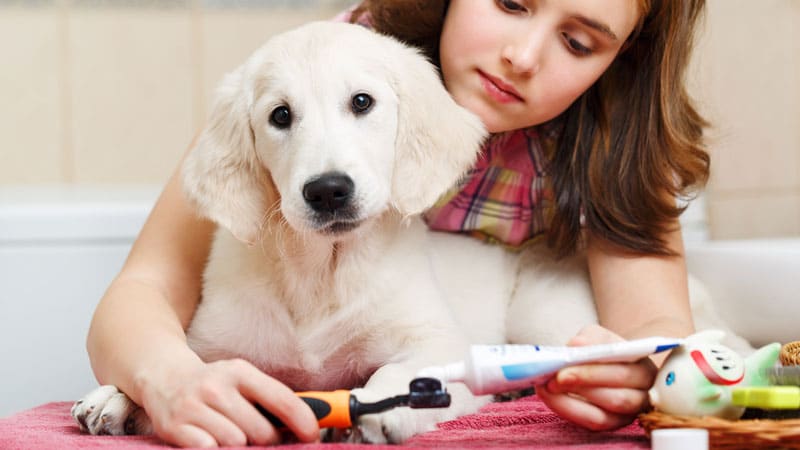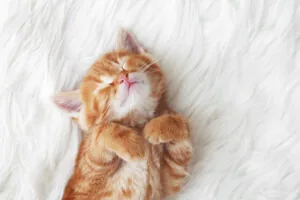How To Keep Your Pet’s Pearly Whites in Mint Condition!

When out in the wild, feline and canine animals keep their mouths clean and free of bacteria by eating grass and also by chewing on bone. Domesticated animals don’t usually do this however, somehow losing awareness of their need to engage in this type of self care; so their bodies produce enzymes to fight off the bacteria whenever it begins to proliferate. Unfortunately, these enzymes can’t win the fight against bacteria on their own. If left uncared for, bacteria will build up and begin causing some severe damage to a pet’s health! So this is where you come in!
Preventative home cleaning is the best way to keep your pet’s mouth squeaky-clean for a long time. In fact, in combination with consistent (usually yearly) dental exams and professional cleanings from your vet, most dental diseases can be prevented by daily pet mouth washing! Read on to learn in a few short steps the best way to care for your pet’s teeth (whether your pet be a cat or a dog).
TEETH CLEANING FOR CATS!
Toothbrushing time for your cat should always be a short and sweet experience. Though the instructions on how to go about it may be somewhat detailed as cats are like people and need to be gently introduced to new things, once your cat gets the hang of it, brushing each tooth only takes a second or less, with a full set of squeaky clean teeth being achievable in a matter of minutes!
STEP #1
Help Your Cat Become “Friends” With the Toothbrush…
Step 1 for cat teeth cleaning is one of the most important steps as your pet’s relationship to the toothbrush will highly influence how often you are able to clean your cat’s teeth and also with what thoroughness level you are able to reach each time! Follow the guidelines listed in step 1 closely in order to best achieve a positive outcome in the battle for clean pet teeth!
- Before anything else, help your cat become comfortable with you putting something into his mouth. Best-selling cat-advice author Pam Johnson-Bennett suggests that during a happy petting session with your cat, you start getting him comfortable with the “item-in-mouth” idea by gently stroking his head and then around his mouth. All the while saying encouraging words. Eventually you can start stroking close to where the teeth are, just getting your cat used to the idea.
- After you have gotten your cat used to having his teeth and mouth area massaged lightly, you will be ready to introduce him to the toothbrush!
Step #2
Using the Toothbrush…
- Make sure the toothbrush is one for cats! You can find cat toothbrushes and finger sponges (which you could use in place of a toothbrush if you prefer) at pet stores, online, and other places like your vet clinic.
- Soak the toothbrush in tuna water so that your cat will want to suck on it!
- After your cat becomes “friends” with his toothbrush, add cat-safe toothpaste to the brush. It is very important not to use human toothpaste as human toothpaste has chemicals in it that are toxic to cats. Also, cat toothpaste is normally flavored with a fish or chicken taste to make it very palatable for your cat!
- When you begin brushing your cat’s teeth, start with the upper teeth first, brushing from the gumline down: remember that your want to brush bacteria off and away from the gums, not into them! As you brush, continually say encouraging words to your cat, and let him know that he is being good!
- You may find, upon starting this new dental routine with your cat, that he will try to pull away from you after you have only brushed a couple of teeth. If he does this, let him! Wait for the next day, or another part of the same day, to brush the rest of his teeth. It’s no use trying to force your cat to have his teeth brushed. This type of action will only be counterproductive. In time, with consistent effort, your pet will become comfortable with the activity.
- After you have brushed the top set of your cat’s teeth, start at the bottom set, brushing from the gumline up this time! This way, once again, you are brushing the bacteria up and away!
- After you have done both sets, believe it or not, the job is complete! Cat toothpaste is not harmful for cats and is made to be edible, so you don’t have to worry about trying to rinse out your cat’s mouth when you are done! That would be a chore indeed!
- If a cat is your only pet, you should be set with dental care tips for the home for now! If you have a pup at home, continue reading for how to go about cleaning your pup’s teeth!
TEETH CLEANING FOR DOGS!
Like their feline counterparts, dogs do need an introduction to teeth cleaning; but unlike cats, they are normally a little more chill about new things being introduced into their pet care routine. Therefore, you can usually be a little more proactive with their care when you begin implementing a teeth cleaning regimen.
Step #1
Getting Your Pup Used to Toothpaste and Toothbrushes
- When helping a pup get used to dental care, it’s a good idea to start by getting a little bit of doggy toothpaste and give it to your pup to taste. Dog toothpaste is often chicken or beef flavored in order to be more appealing to pets! (Remember not to use human toothpaste whatsoever in cleanings).
- Once your dog has enjoyed tasting the toothpaste, you can apply it to a doggy toothbrush. Just like with the cat’s toothbrush, you should be able to find a doggy toothbrush at any pet care store or vet clinic near you.
Step #2
Brushing Your Dog’s Teeth
- Next, while you are saying encouraging words, take your doggy’s toothbrush and gently try to brush one of your pup’s upper fangs (just one or two quick swipes). Make sure to swipe the brush with a downward stroke, away from the gumline.
- If he accepts this initial brushing without a fuss, move on to the next tooth; remember, each tooth literally only needs a quick and gentle swipe or two.
- Continue moving on from tooth to tooth until all your pup’s upper teeth are cleaned or until he starts to become uncomfortable with the routine. Compliment your pet on what a good job he is doing as well! He will love to hear your words of praise or to receive a hug or two from you as you help him learn to clean his teeth!
- After the upper set is clean, you can move down to the bottom set of teeth. The routine for this will be the same as that for the upper row! But you will want to brush or swipe in an upward motion, always keeping in mind that your goal is to get the bacteria away from the gums and off of the teeth. Compliment your pup again for his patience with the routine!
- Never force your pup to accept more cleaning than he can handle. Like your cat, you don’t want to cause him to fear the tooth brushing routine.
- Over time, especially as you consistently do this routine day by day, your puppy will get used to toothbrushing time and may come to enjoy it! (After all, if his toothpaste tastes like chicken, what is there to hate).
. . .
By consistently giving your pet good dental care, you will save your vet a lot of time at the clinic when you take him in for a dental check! You will also be able to save yourself some bucks, as good pet dental care usually prevents serious build-up and disease from occurring. Take care of your pets, and they will take care of your wallet!
Share This Post
Recent Posts
About Shallowford Animal Hospital
Shallowford Animal Hospital and The Pet Spa at Shallowford are dedicated to the exceptional, compassionate care your pet deserves. Pets hold a very special place in our families, and we treat yours like our own.



